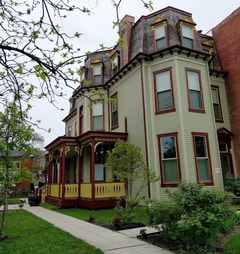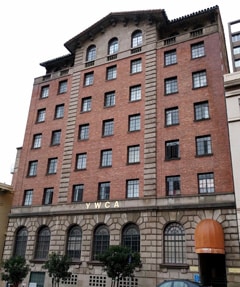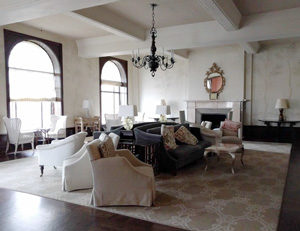As American cities age, local governments face the challenge of how to handle the large stock of old, vacant, and potentially unsafe structures that crowd the cityscape. Cities like Baltimore, Atlanta, and Los Angeles are challenged to find funds to address this situation and often rely on private entities to renew and revitalize city infrastructure. Often this approach leads to the gentrification of neighborhoods.

Linden House, a Shelter Plus Care building in Baltimore, MD dating to 1880.
Gentrification appears to be a reasonable means of handling the task of invigorating a city; private parties invest in a particular building or neighborhood by rehabilitating older structures and creating a new environment. There is, however, a high cost for choosing this route.
Decaying neighborhoods are often populated by low-income families who can only afford the cost of living in potentially unsafe and certainly less-than-ideal housing. The buildings they can afford are often located close to vital city services, such as medical buildings, social services, and metropolitan transportation systems. Low-income families build great social networks within cities and they come to rely on these for emotional, spiritual, and mental health.
Gentrification poses the risk of displacing populations that have long resided in the existing neighborhoods. Investors typically tear down or renovate older buildings with an eye toward higher rent – effectively replacing low-income families with higher-income ones.
A new approach to addressing the needs of existing and often low-income families while also providing safe and sanitary housing lies in historic preservation.
Reinforcing the community through preservation
Large American cities persist because they have a historic presence in our nation. These cities have existed for centuries, and as a result, have a large stock of historic buildings that create great potential for investors. Rather than tearing them down or completely gutting/rehabilitating them, investors have the option to preserve them. This means that, with the council of historic preservation agencies, they can revitalize existing structures. With the help of tax credits or subsidy layers, they can then lease the newly-developed units to the same low-income families who may have otherwise been displaced.

YWCA building from the early 1900s, now Section 202/8
There are many advantages to historic preservation with rent subsidy. First, of course, it preserves a space for low-income families and retains them as vital members of the community. In addition to socio-economic preservation, it also maintains the physical structures that have grown to be essential landmarks in American cities. Buildings made centuries ago are both repurposed and rehabilitated so that they can exist centuries longer. When there is subsidy involved in a building, the building is held to Uniform Physical Condition Standards (UPCS). This means that the building must remain habitable and sanitary as long as there are low-income families living in it. This sharply delays the natural decline of these older buildings. The investor has a stake in the building’s health and this, by default, preserves the building even longer.
Historic preservation also attracts tourists to large cities to see the buildings that helped shape America. This brings more tax dollars to a neighborhood, and can later enhance the scope of services that large cities can provide.
Tenants of historic preservation projects benefit from them not only because they have a safe and sanitary place to live, but also because of the social benefit. First, they are able to remain in their familiar neighborhoods, near the human services that they have come to rely on. New construction projects are often developed in newer areas, further away from the services that support low-income families. Keeping people in the location they have always called home also ensures that their social and family networks stay intact.
Benefits of preservation extend to owners/agents

The living room at the San Francisco YWCA building.
Owners and agents have much to benefit from historic preservation as well. Especially in permanent, supportive housing, one of the major goals in providing low-income housing is to assist residents in reaching their goals. It is far easier to help a resident reach his or her goals when he or she is living somewhere familiar, near services, close to family, and in a beautiful environment. When a resident lives in a revitalized historic building as opposed to, for example, a new tower-style housing project, the resident feels more incentive to participate in the upkeep of the building. A sense of place nurtures a sense of pride that is an extremely important factor in both the resident’s and the owner/agent’s success.
When a housing community is stocked with residents who are proud of where they live, owners/agents are rewarded with generally easier management duties. REAC inspections, for example, may be easier because the building is easier to keep clean with the willing and eager participation of residents. Residents are more likely to report deficiencies when they care about their home, and it’s easier to care about home when you live in a beautiful historic building. This becomes a great feedback loop for the life of the building: residents report issues early, they are repaired, the building maintains its health and continues to provide a beautiful environment for those residents and encourages them to report further deficiencies. When residents are satisfied with the state of their housing, it mitigates problems before they arise. Home becomes a refuge, rather than merely a sleeping place for low-income families. Refuge means relaxation, and that in turn, can result in a more satisfied and less-likely-to-be-disgruntled population.
Finally, one of the most basic management advantages to redeveloping a historic building lies in the subsidy itself. Owners/agents are guaranteed to be paid at least part of the rent each month, as long as they are able to remain in compliance. Unlike unsubsidized projects, where income is entirely at the mercy of residents’ willingness to pay on time, subsidized projects are virtually guaranteed income each month.
Preserving historic buildings as affordable housing is literally a “beautiful” solution that benefits owners, agents, residents, and cities alike. It preserves the best elements of an established neighborhood, from the physical structure to the social one that has grown up around it.
